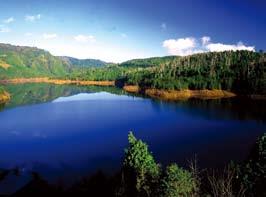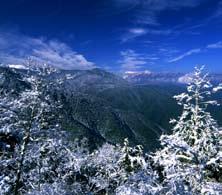Yilan sits in the monsoon climate zone where the northeasterly monsoon winds reign when autumn changes into winter. The temperature is higher in the summer and heavy convection rain often occurs. Combined with a land that is high in the west and low in the east, it rains year round. Typhoon season is from September to December and there is more rainfall than on average. It rains more than 200 days a year to accumulate more than 2,700 millimeters in annual rainfall.
Monthly rainfall is distributed evenly. There is also ample water leftover to accumulate as groundwater. Aquifers consist of coarse sand and gravel and are located in the areas between the top of the alluvial fan and its center. The range of the alluvial fan is approximately defined by the railways. The plains along the coastlines consist mainly of sand or clay. The top and center of the alluvial fan are highly permeable.
When there is ample rainfall, the groundwater below the surface follows the slope to the top of the fan, where pressure often turns it into springs. Coastal areas consist mainly of fine sand and clay which are less permeable. When combined with the effect of the sand hills, faster flowing groundwater from upstream breaks out onto the surface. East to the spot where the Luodong River and the Lanyang River meet is where the groundwater is most abundant on the Plain. Gushers and springs can be seen everywhere, Swimming pools including Songshumen, Longmujing, Longquan, and Longtan are all supplied by underground springs.
Rivers run from west to east and deposit heavy sediment. The strong northeasterly monsoon winds in the winter blow against rivers on the coastline of Yilan to form a sand hill that is 23 kilometers long, 10 meters high, and 200 to 700 meters wide. When the strong northeasterly monsoon winds or typhoons attack, the sand hill is a good shield. However, at other times such height prevents the rivers from flowing directly into the ocean and creates swamp and wetlands instead. The rivers must curve and bend to find a weaker spot on the sand hill to cross over or merge with other rivers in a collaborated effort to make it out to sea. For example, the Lanyang River, Dongshan River, and Yilan River merge near the East Harbor at Zuangwei Village to force an opening out to the Pacific Ocean.
Yilan is endowed and never lacks water. However, the abundance of water brings with it drainage problems. Serious floods have been common place since ancient times. Between 1796 and 1850 there have been as many as 19 recorded wind or water related disasters which caused rivers to change course and crops to flood. Yilan enters the rainy season every autumn and winter. Heavy rainfall may take place suddenly and often. It is a scene that has been described as "rising river and deep mud makes carrying objects difficult; roaring thunders accompanied by racing lightening frighten even the gods".
Among the natural disasters occurring in Yilan, typhoons are the main cause of devastation. Every year between April and October, typhoons that form in the southwest Pacific Ocean tend to proceed in a westerly or northwesterly direction. The odds that a typhoon hit Yilan, which faces the Pacific Ocean to the east, are quite high. In combination with the lack of mountains blocking its way, once a typhoon enters inland it faces no obstacle in its path. The results are often severe loss of life and property damage.
In the early days, the Lower Dongshan River ran on lowlands which combined with sand hills by the sea that blocked flow to the extent a reservoir was formed. Heavy rainfall always caused the reservoir to overflow. In October 1974, Yilan suffered several heavy downpours which caused major floods that broke the riverbanks, destroyed houses, and disrupted traffic. Water flooded the crop fields for months which ended in serious disaster. To mitigate flooding in lower areas, the central government began the project of straightening the Dongshan River in 1975. The project was completed in stages until finished in 1989. It not only improved the flood problems but also established a water park along the Lower Dongshan River and turned it into one of the important tourist attractions in Yilan.

